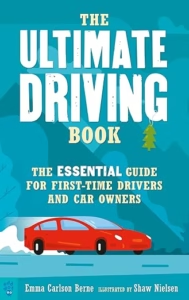The Ultimate Driving Book: The Essential Guide for First-Time Car Drivers and Owners
Emma Carlson Berne
Illustrated by Shaw Nielsen
Odd Dot
Published August 27, 2024
Amazon | Bookshop | Goodreads
About The Ultimate Driving Book: The Essential Guide for First-Time Car Drivers and Owners
From changing a tire, to merging onto a highway, to checking and filling your own oil, The Ultimate Driving Book is the new go-to manual for new and seasoned drivers alike. With 160 pages of full-color illustrations throughout, drivers will have all the step-by-steps they need to navigate life on the road.
Inside, learn how
– Navigate a roundabout or jughandle
– Jump your car’s battery
– Drive in snow or ice
…and so much more!
Plus, use the book’s back pocket to store your insurance and registration documents, then keep it in your glovebox forever!
My Review
I love the idea of this book. It does a lot of things well. The balance between illustrations and text keeps the book informative without being overwhelming. The tone is enthusiastic, and the writing is easy to understand. It’s got great information on a lot of the basics: changing a tire, what to do if you’re in an accident, how to parallel park, what the lights on the dashboard mean, etc. The inclusive illustrations show people in a spectrum of skin tones.
As a Floridian, I doubt I’ll be using the notes on how to dig your car out of a snow bank, but I would have appreciated more information on driving in the rain or what to do when the roadway is underwater.
The last page of the book asks for important vehicle information and phone numbers for insurance claims, emergency contact, and the state highway patrol. The inside back cover is a pocket in which you can keep your insurance card and car registration form, another great idea if you keep this handy book in the glove box.
Overall, I think this book offers good information on some basic driving safety information. I wish it included information on a few additional topics, but I can see how everything that is listed there would be helpful, especially to someone new to spending a lot of time on the road or owning a car.
Content Notes
Recommended for Ages 16 up.
Profanity/Crude Language Content
None.
Romance/Sexual Content
None.
Spiritual Content
None.
Violent Content
References to vehicle accidents or injuries or dangerous roadway situations. The text is brief and informative.
Drug Content
Strongly discourages readers from drinking or using drugs and driving.
Note: This post contains affiliate links, which do not cost you anything to use but help support this blog. I received a free copy of this book in exchange for my honest review. All opinions are my own.
